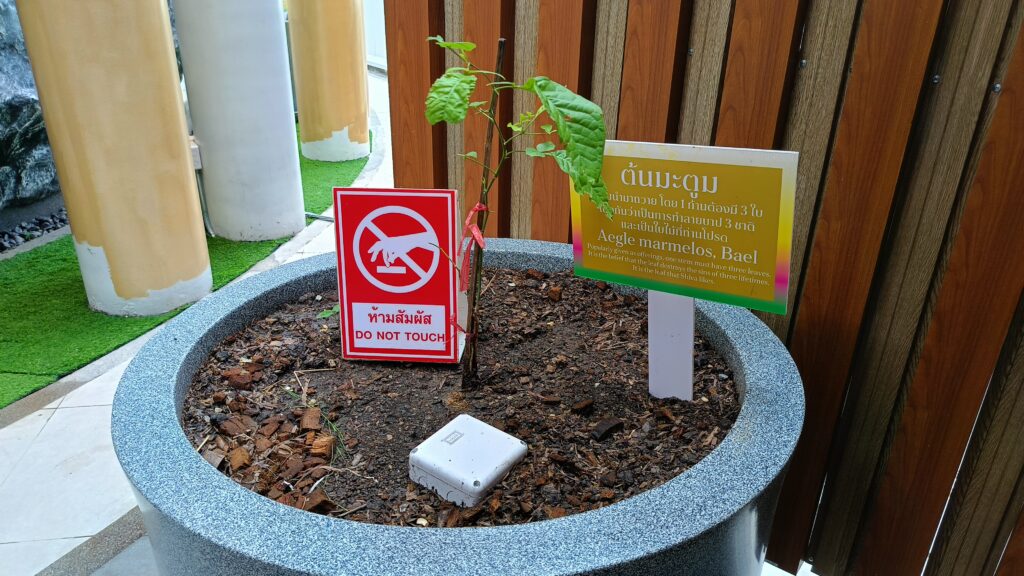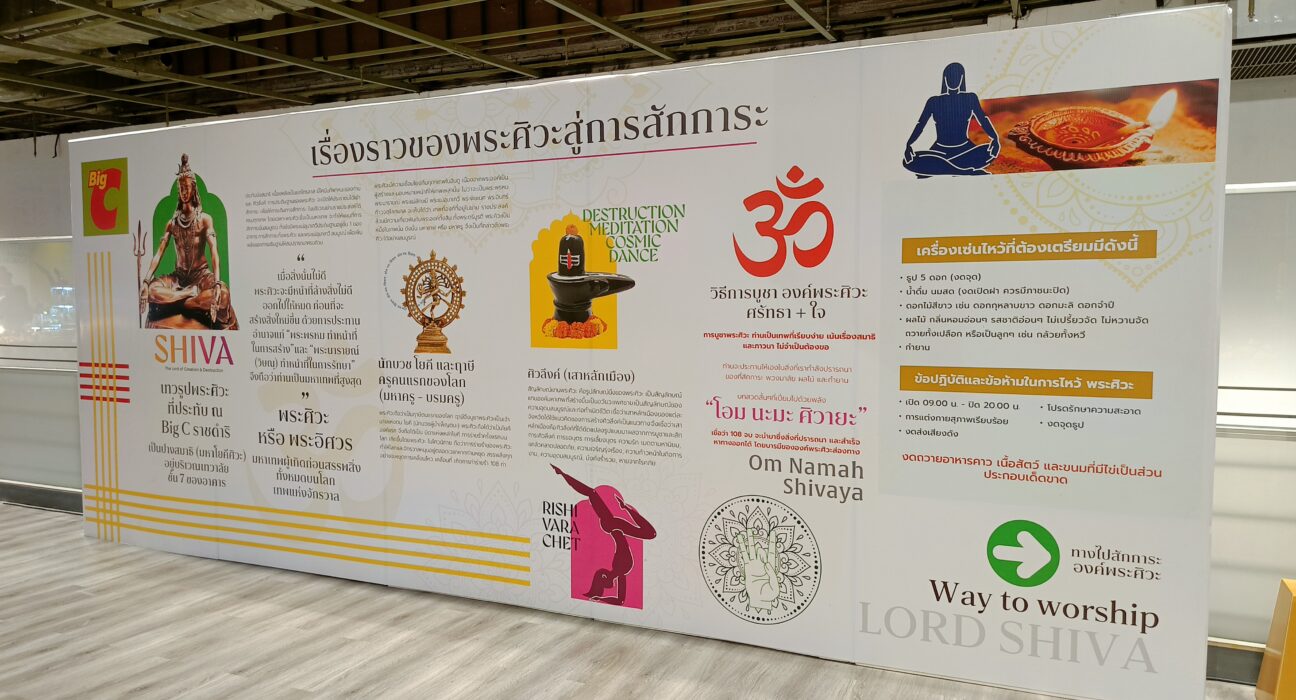On August 6, 2024, Big C Rajdamri, under the BJC Big C Foundation, unveiled a new spiritual landmark for devotees to worship “Mahayogi Shiva” in his meditative form on the 7th floor of the building.
As you step off the elevator on the 6th floor, Ticy City welcomes you with a visual journey through the rich tapestry of Hinduism and the lore of Lord Shiva. This immersive experience along the walkway sets the tone, preparing you to witness the majestic presence of Lord Shiva at the replica of Mount Kailash. On the 7th floor, an open and airy hall leads you past various shops offering items such as flowers, Indian sweets, and religious statues. The walls are adorned with yoga poses and brief stories about Shiva, guiding you toward the worship site under the temple dome of Mount Kailash.

Mahayogi Shiva in Meditation
In this revered form, followers of Shaivism worship Shiva as the supreme deity believed to embody creation, protection, and destruction. The Deva Pratima depicts Lord Shiva seated in deep meditation, with his hands resting on his lap in a traditional yogic posture. His Trident, a symbol of his power, is placed to his right, with the Shivalingam below. The Shivalingam is continuously bathed by clean water flowing from its top down to the yoni base of Uma (Parvati). Devotees often pour clean water (available for 5.50 baht per bottle) over the Shivalingam while chanting the sacred mantra, “Om Namah Shivaya.” In front of Shiva lies Nandhi, his loyal bull, facing the deity. Nandhi serves as Lord Shiva’s vehicle and guardian, while large planters around the hall hold Bael trees (Aegle marmelos), a species favored by Shiva. A sign beside the trees reads: “The Bael tree is often offered with one stalk bearing three leaves, believed to cleanse the sins of three lifetimes and please the Lord.”
…Om Namah Shivaya…Om Namah Shivaya…Om Namah Shivaya…
Let’s briefly explore the story of Lord Shiva.

Rudra: The Origin of Lord Shiva
Lord Shiva, known as “Phra Isuan” in Thai, is an ancient deity with origins in the Vedic era. Initially called “Rudra,” meaning “the weeper,” he was named by Brahma after his incessant crying at birth. Ancient texts refer to him by multiple names, some citing eight, others eleven. In early times, Rudra was the “god of wind, storms, and hunting,” later adopted by the Aryans as one of their deities. Archaeological findings, such as terracotta figures depicting a human with animal horns seated in a yogic posture, are believed to represent Lord Shiva. Evidence suggests that humans have revered and worshiped him for over 3,000 years before the Common Era. The Aryans saw Rudra as a fierce deity who could bring harm to humans, necessitating rituals to appease him. He was regarded as a supreme power, presiding over all praise and sacrificial rituals, and responsible for cleansing and renewing the world.
Rudra eventually evolved into “Shiva,” a name that means “to purify.”

The Image of Shiva
Shiva is depicted as a yogi, ascetic, sage, and the first Guru of the world. His appearance is striking: matted, disheveled red hair, multiple faces (ranging from 1 to 5), and several arms (ranging from 2 to 10). He smears his body with ash from cremated humans, wears a tiger skin, and adorns himself with a necklace of human skulls. His third eye is located in the middle of his forehead, and his weapon, the Trident, symbolizes his power. His abode is Mount Kailash, also known as Mount Phra Sumeru. Shiva has 48 names, each reflecting a different aspect of his divine nature. Some examples include “Bhuteshwar” (the lord of spirits, residing in cremation grounds), “Trilochana” (the three-eyed god), “NilaKantha” (the blue-necked one, who drank poison during the churning of the ocean to save the world), “PANCHMUKHI SHIVA” (the five-faced deity), and “SADASHIVA” (the supreme form of Shiva with five heads—the Trimurti at Central World is actually SADASHIVA, not the Trimurti). Shiva’s most significant festival is Maha Shivaratri.
Devotees often wear Rudraksha beads as necklaces or bracelets. These beads come from the seeds of a large tree, believed to have sprouted from Shiva’s tears when he wept over the suffering of the world. These tears became the Rudraksha tree, also known as “Shiva’s Tears,” and are considered powerful amulets.
Another widely recognized form of Shiva is the “Shivalingam,” revered by both Asians and Westerners alike. In Southeast Asia, particularly in places like Cambodia, Java, Indonesia, Bali, and Sumatra, the Shivalingam is even more popular than Shiva’s human form. A complete Shivalingam includes the yoni base of Uma (Parvati), symbolizing the male-female union, the source of new life, and fertility.

Nataraja: The Supreme Lord of Dance
Shiva is also revered as the supreme Guru of dance, or Natya Shastra, in India. His cosmic dance, known as “Taṇḍava natyam,” is believed to set the rhythm of the universe, with the ḍamaru drum (an hourglass-shaped drum) in his hand. The graceful yet powerful movements of his eyes, arms, legs, wrists, waist, and hips keep the world and the cosmos in perpetual motion. If he stops, everything ceases. This dance is also the foundation of yoga practice.
As part of the Trimurti, Shiva is the Destroyer, Brahma is the Creator, and Vishnu (Narayana) is the Preserver. However, in Shaivism, Shiva is regarded as the Creator, Preserver, and Destroyer, existing before all things in the world.
His consort is Parvati (a reincarnation of Sati), who, like her husband, embodies both fierce and gentle qualities. She has many avatars, such as the nine forms of Navadurga, the ten forms of Gali Goddess (Dasha Mahavidya in Tantra), and others. Together, Shiva and Parvati have two sons: Lord Murugan and Lord Ganesha. Shiva also has an adopted daughter, Manasa (the goddess of snakes and nagas), who does not get along with Parvati.
Stay tuned for the next chapter, where God’s City by Nai Mu from Ticy City will introduce you to another deity!
Written by: Nai Mu
God’s City















Leave feedback about this